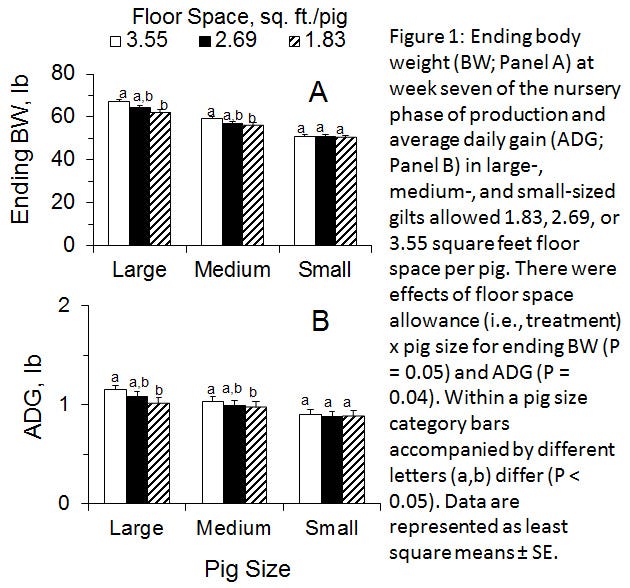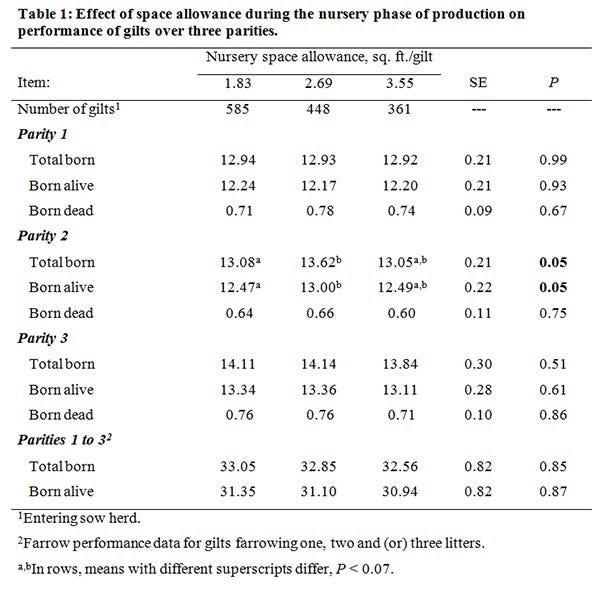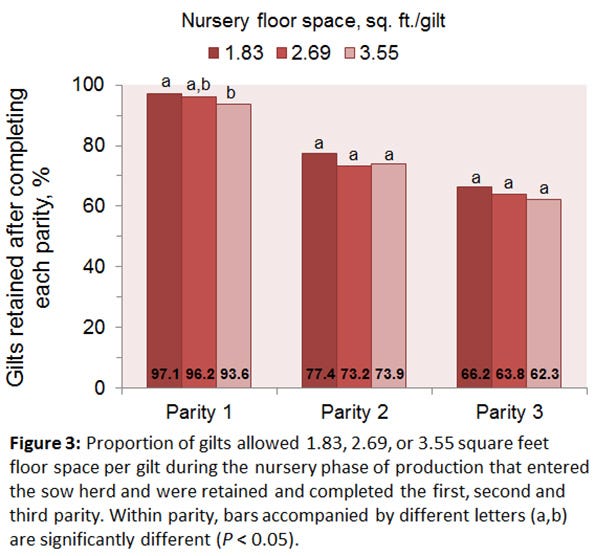April 17, 2015

Research conducted to determine how to best manage replacement gilts in order to capture reproductive efficiency has traditionally focused on the grow-finish stage of production and more specifically, when females are nearing sexual maturity. While management during that period greatly influences reproduction, it has become evident that how the developing gilt is managed earlier in life may also have profound effects on reproductive performance and longevity in the sow herd. This article describes research that has been conducted to examine the effects of environmental conditions to which replacement gilts are exposed on lifetime reproductive performance and longevity, and will pay particularly close attention to effects of nursery floor space allowance.
In intensively managed swine operations, there are many potential environmental stressors that may negatively impact reproduction in gilts. As examples, puberty onset is delayed for gilts exposed to severe “heat stress” conditions (continuous temperatures exceeding 90 degrees F) compared to gilts kept at their optimum temperature of 60 degrees F, and for gilts exposed to aerial concentrations of ammonia of 21 parts per million compared to gilts housed in an environment with concentrations of ammonia of 5 ppm or less. Clinical signs of environmental stressors are often easily detected. Temperatures below the thermal comfort zone of 75 to 85 degrees F cause recently weaned nursery pigs to huddle and shiver. Inadequately ventilated barns may cause coughing indicative of respiratory distress, and animals housed in pens with poor flooring may display lameness.
A stressor that is often operative, but which may not have easily discernible consequences, is stress due to inadequate floor space, and there is evidence that this stressor may negatively impact reproductive performance. Early work done by M.D. Lindemann in Virginia and Kentucky revealed that the percentage of gilts reaching puberty at less than 285 days of age tended to be greater for females allowed adequate floor space during the grower phase of production (6 square feet), compared to gilts allowed less floor space (3 square feet). In Alabama, Kuhlers and colleagues placed developing gilts in pens of eight or 16 animals each and the females reared in the smaller groups ultimately farrowed one more pig per litter than did gilts reared in the larger groups. More recently, researchers from Kansas State University conducted an experiment during which 1,257 gilts at 75 days of age and approximately 84 pounds body weight were placed in pens of 15 or 22 animals each, thus allowing 12.16 or 8.28 square feet of floor space per gilt, respectively. The percentage of gilts that attained puberty by 200 days of age was significantly greater (37.2 versus 30.3%), and age at puberty was significantly less (182 versus 184 days of age) for gilts allowed the greater amount of floor space. However, space allowance did not affect growth rate in rearing, or the total pigs produced over three parities or removal rate once gilts entered the sow herd.
It is reasonable to speculate that the immediate post-weaning environment (i.e., nursery phase of production) in which gilts are raised may ultimately influence reproduction as well. Moreover, stress of crowding in the nursery, compared to the grow-finish barn, could perhaps be more damaging to future reproduction because pigs are young and still “fragile”, and experiencing developmental setbacks during this stage when reproductive function is still malleable could have significant impacts on lifetime reproduction. These hypotheses were tested in a recent study, the objective of which was to determine if floor space allowance during the nursery phase of rearing affects growth, physiology, immunology and future reproduction and longevity in gilts.
Animal work was performed at production facilities owned and operated by Murphy Brown LLC in Cameron, N.C., and a total of 2,537 gilts from 13 consecutive weekly groups of weaned pigs were used. Pigs were weaned at approximately 22 days of age and weighing approximately 12 pounds, sorted into groups based on the size of pig (large, medium and small) and then within size, randomly placed in nursery pens to allow 1.83, 2.69, or 3.55 square feet floor space per gilt. This was accomplished by altering the number of pigs placed in the various pens (14, 11 or eight, respectively). Gilts were weighed at the beginning and end of the seven-week nursery phase of production and average daily gain determined. Blood samples were collected from a subset of gilts (18 gilts per floor space allowance) to determine blood chemistry profiles, complete blood count and cortisol levels. After leaving the nursery, gilts were managed similarly and subsequent reproductive performance was determined through three parities on 11 different sow farms.
Performance of gilts in the nursery
As expected crowding negatively impacted growth, particularly in large- and medium-sized pigs. As shown in Figure 1, large- and medium-sized gilts allowed the most floor space had significantly greater body weights after seven weeks in the nursery and ADG compared to large- and medium-sized gilts allowed the least amount of floor space.
In contrast body weights at week seven and ADG were similar for small-sized gilts allowed the different amounts of floor space. Although the design of the feeding system used in this study prevented us from determining feed disappearance for individual pens, it is widely accepted that decreased ADG due to crowding is a result of a decrease in feed intake.
Although growth was negatively impacted by reducing floor space allowance, the proportion of pigs that died during the nursery phase of production was similar for the different treatment groups and ranged from 2.3 to 2.4%. Additionally, physiological and immunological indicators of stress determined in the collected blood samples were similar for gilts allowed the different amounts of floor space. For example, there were no significant effects of treatment on serum concentrations of cortisol or the ratio of neutrophils to lymphocytes, two types of white blood cells (Figure 2). For livestock, increased blood concentrations of cortisol and an increased ratio of neutrophils to lymphocytes are commonly used biomarkers for acute and chronic stress, respectively.
Floor space allowance in the nursery did affect some blood chemistry measures. For example, concentrations of calcium for gilts allowed the greatest and intermediate amounts of floor space were similar, but both were significantly greater than concentrations for gilts allowed the least amount of floor space. Concentrations of chloride were significantly greater for gilts given the least amount of floor space compared to gilts given the intermediate amount of floor space with gilts given the greatest amount of floor space having an intermediate value.
Gilt reproductive performance and longevity in breeding herd
The flow of gilts within this production system did not allow us to determine age at puberty, however, in a different study, researchers at Iowa State University showed a weak but statistically significant relationship between body weight at 75 days of age and age at first estrus for those gilts achieving puberty by 200 days of age. Because large- and medium-sized gilts allowed the greatest amount of floor space in the nursery were heavier than similar sized pigs allowed the least amount of floor space after completing the nursery phase of production (approximately 70 days of age), it is tempting to speculate that the heavier gilts may have also reached puberty sooner.
Moreover, in the study described here, vulva measurements were also determined for a subset of 30 animals (10 gilts per floor space allowance) and vulva width tended to differ among groups being 25.0, 28.0, and 28.0 millimeters for gilts allowed 1.83, 2.69, or 3.55 square feet floor space per head, respectively. Previous work at ISU revealed correlations between vulva width in gilts at both 105 and 115 days of age and their age of first estrus. The biological basis for changes in vulva area being a useful marker is that from 75 to 115 days of age, gilts will begin to exhibit the initial waves of tertiary follicle development on their ovaries. Around 75 days of age, all gilts typically lack tertiary follicle development while most gilts possess these stage follicles on their ovaries by 115 days of age. These tertiary follicles produce enough estrogen to enable growth of the reproductive tract, including the vulva. Thus, it’s feasible that those gilts demonstrating larger vulva development first during this phase are more likely to have initiated the ability to recruit and grow initial tertiary follicles. In fact, between 95 and 115 days of age, a much smaller percentage of those gilts whose vulva area is less than one standard deviation from the mean vulva area in a cohort of gilts are expected to achieve their first estrus by 180 days of age, compared to the rest of the gilts in the cohort. Therefore, it appears logical that if restrictions in floor space have negative implications on the development of the vulva, it may be an indication that follicular events are also being delayed.
Farrowing performance data for gilts in the first, second and third parity, as well as the total for parities 1 through 3 is contained in Table 1. Performance was similar among groups for parities 1 and 3, as well as total production over three parities. However, the total number of pigs born and the number of pigs born alive were significantly greater for gilts each allowed 2.69 square feet floor space compared to gilts each restricted to 1.83 square feet floor space. Gilts allowed the greatest amount of floor space had intermediate values for total born and born alive that were not significantly different from the other two groups. Figure 3 depicts the proportion of gilts that entered the sow herd that completed parities 1, 2 and 3. Interestingly, a greater percentage of gilts each allowed 1.83 square feet nursery floor space completed parity 1 compared with gilts each allowed 3.55 square feet. There were no differences among treatments for the other two parities.
Figure 3 depicts the proportion of gilts that entered the sow herd that completed parities 1, 2 and 3. Interestingly, a greater percentage of gilts each allowed 1.83 square feet nursery floor space completed parity 1 compared with gilts each allowed 3.55 square feet. There were no differences among treatments for the other two parities. The research summarized herein provides evidence that stimuli to which gilts are exposed in the nursery may result in adaptations that have lifelong physiologic consequences. Most notably, parity 2 litter sizes, and the proportion of gilts entering the sow herd that complete parity 1, are impacted by alterations in nursery floor space allowance. Research will continue to identify early-in-life stressors and to develop management strategies for mitigating adverse effects on reproduction and increasing sow longevity.
The research summarized herein provides evidence that stimuli to which gilts are exposed in the nursery may result in adaptations that have lifelong physiologic consequences. Most notably, parity 2 litter sizes, and the proportion of gilts entering the sow herd that complete parity 1, are impacted by alterations in nursery floor space allowance. Research will continue to identify early-in-life stressors and to develop management strategies for mitigating adverse effects on reproduction and increasing sow longevity.
You May Also Like



